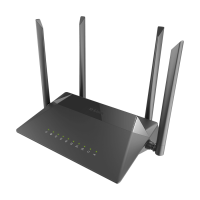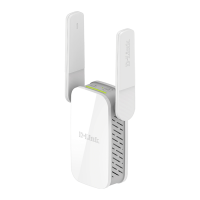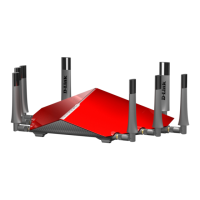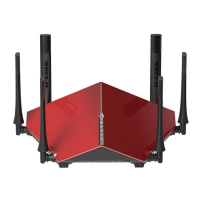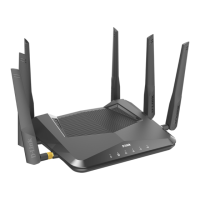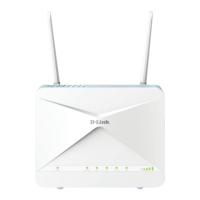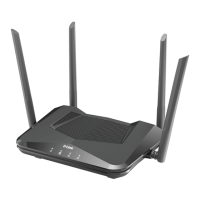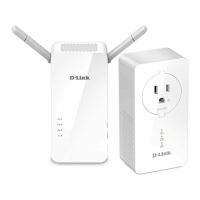Do you have a question about the D-Link AC1750 and is the answer not in the manual?
| Ethernet LAN | Yes |
|---|---|
| Cabling technology | 10/100/1000Base-T(X) |
| Networking standards | IEEE 802.11a, IEEE 802.11ac, IEEE 802.11g, IEEE 802.11n, IEEE 802.3, IEEE 802.3u |
| Ethernet LAN data rates | 10, 100, 1000 Mbit/s |
| Ethernet LAN interface type | Gigabit Ethernet |
| Wi-Fi band | Dual-band (2.4 GHz / 5 GHz) |
| Wi-Fi standards | 802.11a, Wi-Fi 5 (802.11ac), 802.11g, Wi-Fi 4 (802.11n) |
| Top Wi-Fi standard | Wi-Fi 5 (802.11ac) |
| USB 2.0 ports quantity | USB 2.0 ports have a data transmission speed of 480 Mbps, and are backwards compatible with USB 1.1 ports. You can connect all kinds of peripheral devices to them. |
| Ethernet LAN (RJ-45) ports | 1 |
| USB version | 2.0 |
| Input current | 2.5 A |
| Rack mounting | No |
| Frequency range | 2.4 - 5 GHz |
| DHCP client | - |
| Supported network protocols | IPv6 |
| Security algorithms | WPA, WPA2, WPS |
| Certification | FCC\\r IC\\r Wi-Fi\\r CE |
| Operating temperature (T-T) | 0 - 40 °C |
| Operating relative humidity (H-H) | 10 - 95 % |
| Product color | Black |
| Mac operating systems supported | Mac OS X 10.4 Tiger |
| Windows operating systems supported | Windows 7 Home Basic, Windows 7 Home Basic x64, Windows 7 Home Premium, Windows 7 Home Premium x64, Windows 7 Professional, Windows 7 Professional x64, Windows 7 Starter, Windows 7 Starter x64, Windows 7 Ultimate, Windows Vista Business, Windows Vista Business x64, Windows Vista Enterprise, Windows Vista Enterprise x64, Windows Vista Home Basic, Windows Vista Home Basic x64, Windows Vista Home Premium, Windows Vista Home Premium x64, Windows Vista Ultimate, Windows Vista Ultimate x64 |
| Cables included | LAN (RJ-45) |
| Depth | 103 mm |
|---|---|
| Width | 125 mm |
| Height | 218 mm |
| Weight | 530 g |
Details of the revisions made to the manual, including dates and descriptions of changes.
Information regarding D-Link and third-party trademarks used in the manual.
Lists the items included in the product package for the D-Link DIR-868L router.
Details the network and computer requirements for setting up and using the router.
Provides an overview of the DIR-868L router's features, including speed and cloud services.
Describes the physical ports and buttons on the router.
Explains the status indicators (LEDs) on the router and their meanings.
Preparation steps before installing the router, including modem configuration and DSL/Cable provider info.
Guidelines for optimizing wireless signal range and performance.
Step-by-step instructions for connecting the router to your modem and computer.
Instructions for connecting the DIR-868L to an existing router as an access point or switch.
A guided process to configure the router for internet connection and basic settings.
Using the QRS Mobile App for router setup via smartphone or tablet.
Accessing files from a USB drive connected to the router via the SharePort Mobile App.
Accessing and using the router's web interface for advanced configuration.
Configuring various types of internet connections like PPPoE, Dynamic, Static, etc.
Configuring wireless network name (SSID), security, and modes for 2.4GHz and 5GHz bands.
Understanding WPA/WPA2 security features to protect your wireless network.
Step-by-step guide to enable WPA/WPA2-Personal security using a pre-shared key.
Configuring WPA/WPA2-Enterprise security using a RADIUS server for authentication.
Configuring the router's IP address, subnet mask, and domain name.
Configuring the router as a DHCP server to assign IP addresses to network clients.
Assigning static IP addresses to specific devices on the network.
Opening specific ports to allow external access to internal network services.
Configuring rules to forward incoming traffic to specific devices or applications.
Defining rules for specific applications that require multiple connections.
Prioritizing network traffic for improved performance of online games and applications.
Controlling network access based on MAC addresses of connected devices.
Implementing parental controls and limiting web access based on time or dates.
Creating lists to allow or deny access to specific websites.
Configuring inbound data filtering rules based on IP address ranges.
Configuring SPI firewall features and DMZ settings for network protection.
Customizing specific routes for data movement within the network.
Adjusting wireless transmit power and enabling features like WMM and coexistence.
Setting up Wi-Fi protection using WPS PIN or Push-Button methods.
Configuring UPnP, WAN Ping Response, and multicast stream settings.
Creating separate wireless zones for guests to access the internet.
Configuring firewall rules for IPv6 traffic to control access.
Specifying custom routes for IPv6 data movement within the network.
Changing administrator password, gateway name, and enabling remote management.
Configuring the router's time zone, daylight saving, and time synchronization.
Enabling logging and sending router logs to a SysLog server.
Configuring email notifications for system logs, alerts, and firmware updates.
Managing configuration settings, rebooting the router, and restoring factory defaults.
Upgrading the router's firmware and language packs.
Setting up Dynamic DNS to host servers using a domain name.
Performing ping tests to check internet connectivity for IPv4 and IPv6.
Creating schedules to enforce rules for web access or other network activities.
Displays current router information, including LAN, WAN, and wireless status.
Viewing and saving router event logs.
Displays traffic statistics for WAN, LAN, and wireless segments.
Shows details of active internet sessions between LAN and WAN computers.
Lists current connected wireless clients, their connection rate, and MAC address.
Instructions for connecting wireless devices using the router's WPS button.
Steps to connect to a wireless network using Windows 8.
Steps to connect to a wireless network using Windows 7 with WPA/WPA2.
Steps to connect to a wireless network using Windows Vista.
Steps to connect to a wireless network using Windows XP with WPA/WPA2.
Solutions for accessing the router's web interface, including browser and connectivity checks.
Instructions on how to reset the router to factory defaults if the password is forgotten.
Troubleshooting connection issues to specific sites or emails, suggesting MTU adjustments.
Explains wireless technology and its benefits for home and office use.
Describes the two basic modes of networking: Infrastructure and Ad-Hoc.
Steps to verify your IP address using ipconfig command on different Windows versions.
Guide on how to manually assign a static IP address in Windows for network connectivity.
Lists the IEEE standards supported by the router's wireless and wired interfaces.
Details the physical ports and buttons available on the router hardware.
Specifications for the 802.11ac and 802.11n wireless interfaces, including frequencies and modulation.
Information about the router's LEDs, including Power/WPS and Internet indicators.
Specifies the power requirements for the router.
Introduction to the GNU General Public License and its principles.
Defines terms like 'Program', 'modify', 'propagate', and outlines source code requirements.
Details the hardware warranty period and D-Link's obligations for repairs or replacements.
Specifies the warranty terms for the router's software portion.
Procedure for submitting a warranty claim within the United States.
Procedure for submitting a warranty claim within Canada.
Lists conditions and damages not covered by the D-Link Limited Warranty.
States that the product is provided 'AS-IS' and disclaims other warranties.

